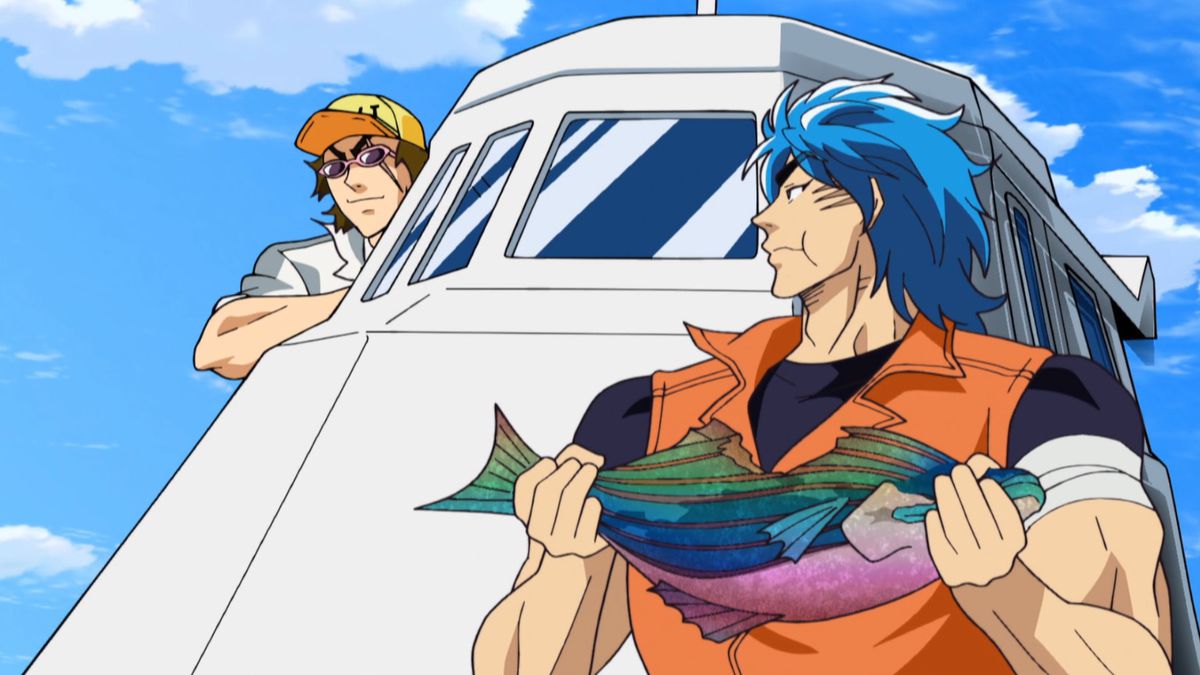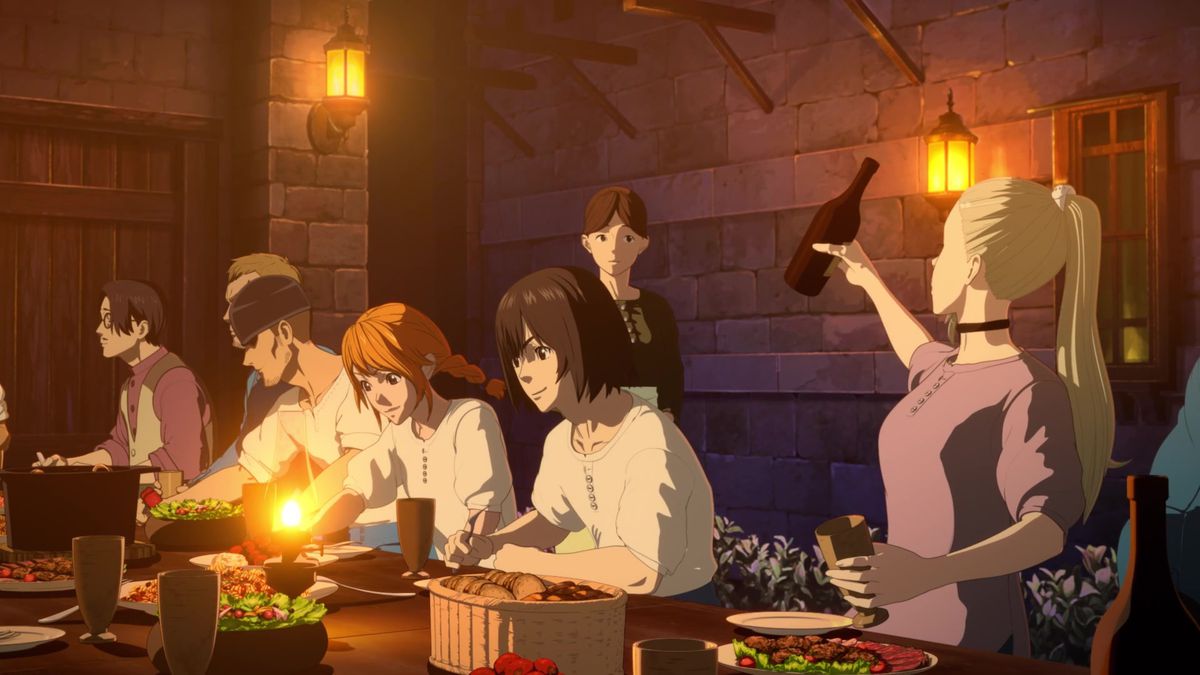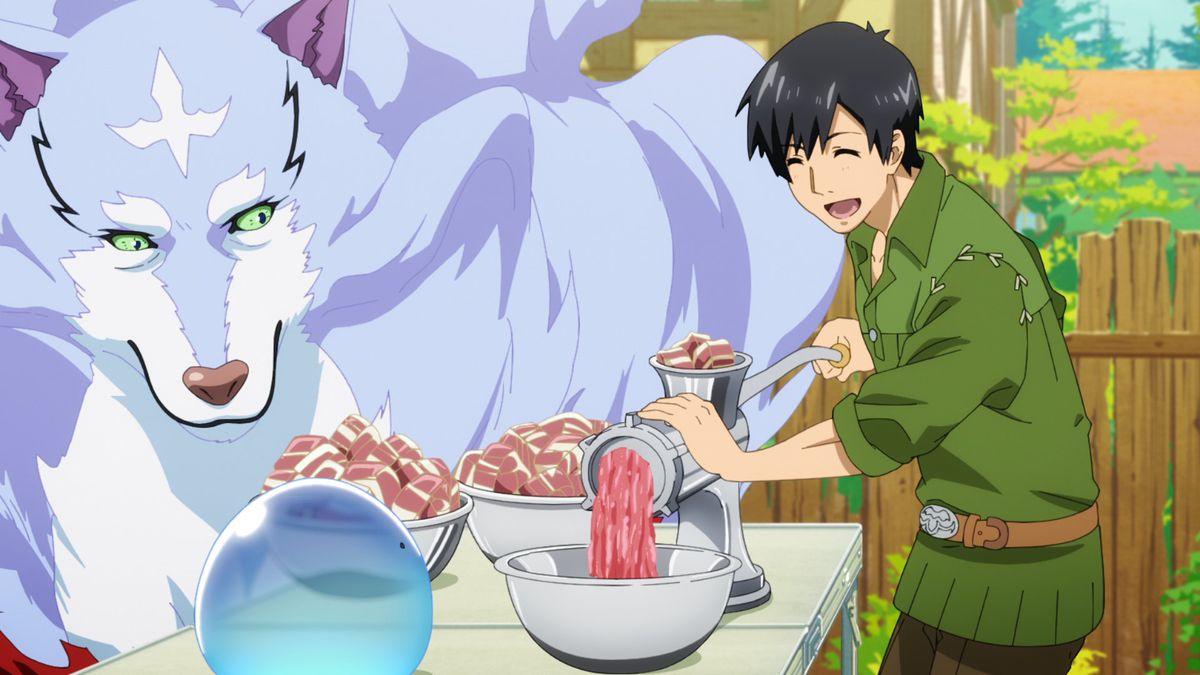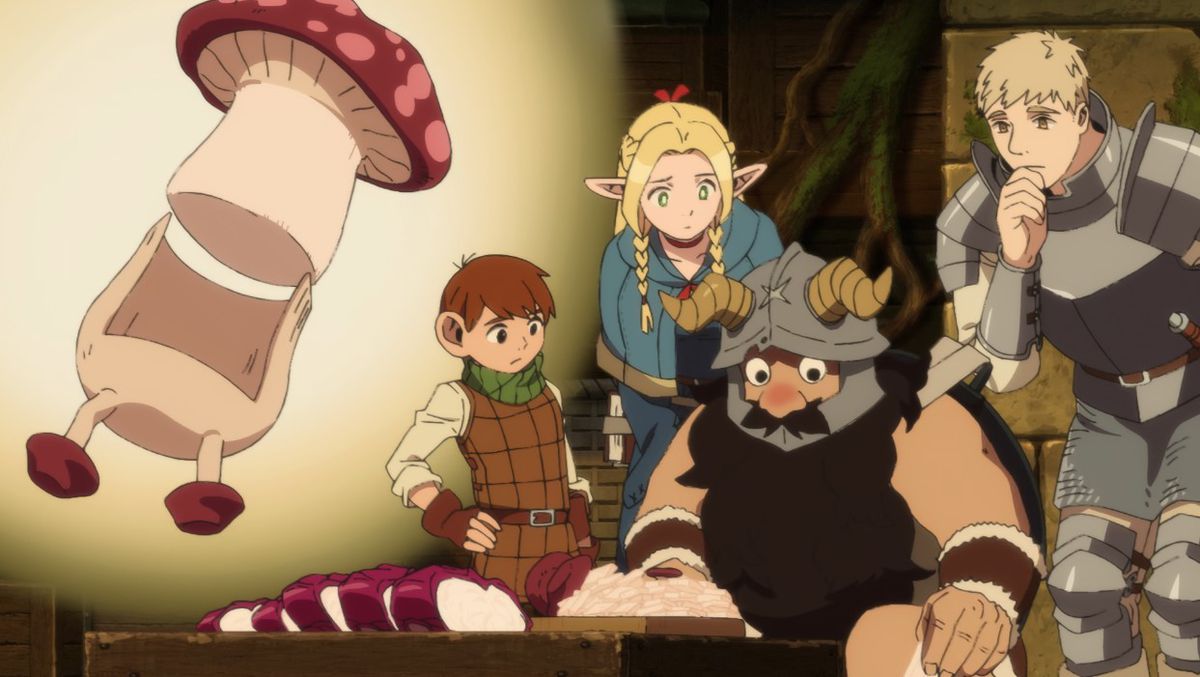Delicious in Dungeon, the new culinary fantasy anime from Studio Trigger (Cyberpunk: Edgerunners) that premiered on Netflix earlier this month, does a lot in the opening five minutes of its first episode.
In that short time, the series establishes its setting (a fantasy world with a magical subterranean dungeon), stakes (adventurers having to reach a far-off level of the dungeon before their comrade gets digested by the dragon that swallowed her), and, finally, its unique hook: To get to their destination quickly, our heroes choose not to waste time earning money to buy provisions and instead opt to eat the dungeon monsters they encounter along the way.
Image: Studio Trigger/Netflix
With this, Delicious in Dungeon transforms the fantasy genre and becomes a fascinating mix of intense sword-and-sorcery battles, slice-of-life comedy, and calm moments dedicated to the preparation and eating of mouthwatering dishes like Huge Scorpion and Walking Mushroom Hotpot, Man-Eating Plant Tart, and more. This premise not only makes Delicious in Dungeon stand out among other recent fantasy fare, but positions it as the latest example in an emerging genre of culinary-themed shows that I would call “action gourmet” anime. This new genre mixes heart-pounding fights with prolonged breaks centered on food in the tradition of iyashikei (literally Japanese for “healing”) anime where things like antagonists, conflict, or drama are replaced with relaxing slice-of-life scenes to help audiences appreciate the simpler things in life.
While the subgenre of action gourmet is only just now coming into its own, there are plenty of examples of shows out there to justify this new categorization, each iterating on the basic elements of the genre in their own deliciously interesting way.
Toriko: a cartoonish but endearing love letter to food

Image: Toei Animation/Funimation
Where to watch: Hulu and Crunchyroll
At first glance, Toriko could not be more different from Delicious in Dungeon. The latter, based on a manga by Ryoko Kui, is about being open to unconventional culinary experiences, like a fantasy take on Anthony Bourdain: No Reservations. Toriko, which is based on Mitsutoshi Shimabukuro’s manga, is closer in style to a Merrie Melodies cartoon. Imagine a world where roasted meat grows on trees. A world brimming with ramen simmering in bowl-shaped lilies, hamburgers dangling from clovers, and syrupy pancake fruit. That’s the world that Toriko, a “Gourmet Hunter” with superhuman strength, traverses in search of the ultimate ingredients to create a perfect full-course meal.
For all their differences, Toriko and Delicious in Dungeon do follow the basic action gourmet formula: outlandish action followed by calm scenes where characters prepare and indulge in delectable dishes that stand out even by the famously high standards of anime food. What is also noteworthy about Toriko is that its first episode was actually a crossover with One Piece, a series that may have sown the seeds of this new anime genre.
One Piece: an early ingredient of action gourmet anime?

Image: Toei Animation/Crunchyroll
Where to watch: Crunchyroll, Netflix, Hulu
In the first episode of Toriko, the main character and his sidekick cross paths with the Straw Hat Pirates on a food-filled island and join forces to hunt ferocious Barbecue Pigs that conveniently come pre-grilled. The crossover was a natural fit, as food plays a big role in both shows. The world of One Piece is home to such fantastical locales as Whole Cake Island, and many of its main characters are associated with food, including Luffy’s love of meat on the bone, Franky being literally powered by cola, Chopper’s passion for cotton candy, or Nami’s personal history with mikan (satsuma mandarins). That doesn’t make One Piece an action gourmet anime per se, but its Toriko crossover definitely laid the foundation for this emerging genre.
Another example is in the 197th episode of One Piece, where cook Sanji shows up two cocky chefs by cooking a delicious meal out of the scraps they left behind. With this episode coming at the end of the adrenaline-pumped Skypiea Saga, one could argue that this one slow episode of the G-8 Arc could be considered a possible predecessor to modern action gourmet anime.
Drifting Dragons: a half-baked premise with a serious message

Image: Polygon Pictures/Netflix
Where to watch: Netflix
Delicious in Dungeon and Toriko are ultimately food fiction, set in fantasy worlds filled with even more fantastical ingredients, while One Piece’s 197th episode offers real kitchen tips, like how spare meat scraped off bones can be made into meatballs to make sure nothing goes to waste. The 2020 anime Drifting Dragons has a similar tone, following the story of a whaling ship and its crew — though, in this case, the “whaling ship” is an airship and the “whales” are dragons hunted by “drakers.”
Adapted from a manga by Taku Kuwabara, the anime features many sky-high dragon hunts, but large portions of the series are dedicated to scenes of drakers rendering dragon fat or scraping meat from bones for cooking. Kuwabara puts a lot of emphasis on the backbreaking work that goes into procuring certain foods and ingredients, and while the whaling allegory may seem a bit dated, the message of respecting the behind-the-scenes efforts in food production is still applicable to some foods obtained in perilous conditions, like snow crabs. It’s a show that fosters the audience’s appreciation for food, while also giving them tips on how to make certain dishes, like preparing a steak sandwich using stale bread in the first episode or “alla diavola” grilled meat in episode 2. Other action gourmet shows have featured real-life cooking techniques in their storytelling.
Campfire Cooking in Another World with My Absurd Skill: the joy of modern conveniences

Image: MAPPA/Crunchyroll
Where to watch: Crunchyroll
There is an old internet joke that goes: “We take it for granted, but a single Dorito has more extreme nacho flavor than a peasant in the 1400s would get in his whole lifetime.” Campfire Cooking in Another World with My Absurd Skill is like the anime version of that.
Based on a light novel series by Ren Eguchi, the anime follows an office worker who is transported to a fantasy world and tries to live a simple life by making use of his unique skill: being able to buy things from modern Japan via a magical equivalent of the internet. He then uses these ingredients to cook meals unlike anything his new home had ever seen or tasted, to the astonishment of those around him.
Like Drifting Dragons, Campfire Cooking in Another World with My Absurd Skill features real cooking techniques. But here, they are more of a celebration of all the amazing, rich flavors we take for granted. In the first episode of the anime, the main character gets a powerful magical familiar because he serves ginger pork using a simple sauce in a bottle that can be found in any Japanese supermarket. While this sauce wouldn’t be extraordinary in our world, to the creature and other characters in this world, it’s one of the most amazing things they’ve ever tasted. In Campfire Cooking, Ren Eguchi often stages massive fantasy battles only to then turn down the heat by showing appreciation to the modern conveniences and the joys of simple yet flavorful meals. This love of food wafts throughout not only this show, but every anime in the emerging genre of action gourmet.

Image: Studio Trigger/Netflix
At the end of the first episode of Delicious in Dungeon, the knight Laios says that the reality of life is that “to eat is the privilege of the living.” For all the anime’s fantasy elements, it’s a very raw message that cuts to the bone, emphasizing the relationship between food and those who consume it. Delicious in Dungeon, Toriko, Drifting Dragons, Campfire Cooking in Another World with My Absurd Skill, and more all take different approaches to this same message, but are all ultimately preaching the same thing.
It could also be argued that another important ingredient of an action gourmet anime is the juxtaposition of action and iyashikei scenes to enhance both, like how certain flavors are more pronounced when paired with their opposites. By weaving together a story out of contrasting tones, action gourmet shows make their action more exciting and their food scenes more relaxing. More shows need to come out and experiment with the formula for the action gourmet genre to fully develop, but the journey so far has been absolutely delicious.

